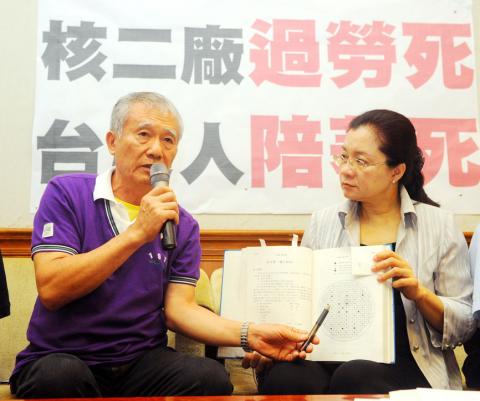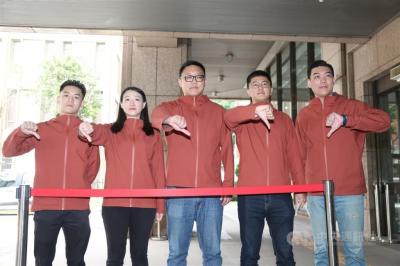Cracks of up to 30cm have been found on the core shroud of the No.1 reactor at the idled Guosheng Nuclear Power Plant in Wanli District (萬里), New Taipei City (新北市), an Atomic Energy Council official has confirmed.
Civic groups yesterday warned against reactivating the plant.
In addition to unsettled concerns about cracked anchor bolts at the reactor, Green Consumers Foundation chairman Jay Fang (方儉) revealed that two cracks were found on welded parts of the core shroud, which Fang said could lead to disaster if the reactor is reactivated without repairs.

Photo: Wang Min-wei, Taipei Times
Deputy Director of the Atomic Energy Council’s (AEC) Department of Nuclear Regulation Chen Yi-pin (陳宜彬) was quoted by the Chinese-language Liberty Times (the Taipei Times’ sister newspaper) yesterday as having confirmed on Sunday that the two long cracks were discovered during routine checkup and maintenance in March.
The core shroud is a large cylinder of circumferentially welded plates made of stainless steel, surrounding the reactor fuel core, which is composed of fuel rods assembled into bundles.
According to Chen, the cracks at the core shroud’s weld bead are located near where the most neutrons are emitted in the reactor core, and embrittlement of the weld bead is a result of stress corrosion from neutron exposure, adding that “it is a common problem of boiling-water reactors that has been known for over 20 years.”
Chen was also quoted as saying that cracks of 20cm were found at the first reactor six years ago and that even if holes were found on the core shroud, it would only affect the thermal efficiency as long as the reactor is still intact.
Lee Kuei-lin (李桂林), a retired Taiwan Power Co (Taipower) employee who had worked at the plant for 33 years, told a press conference yesterday that the Guosheng Nuclear Power Plant had had many instances of sudden emergency shut-downs and the thermal effect from a sudden drop in temperature from 300oC in the reactor core may be the real cause of the cracks.
As the top guide and core plate, which are welded onto the shroud, provide horizontal support for the fuel assemblies, the core shroud cracking may lead to instability or displacement of the guide and the plate, resulting in the misalignment of the fuel bundles, he said.
He added that control rods cannot be inserted between the fuel bundles if they are slightly misaligned, so a critical problem that could arise would be the loss of fuel core cooling capability.
The worst-case scenario that could, in turn, result from the inability to insert controls rods would be a core meltdown, he warned.
Democratic Progressive Party Legislator Tien Chiu-chin (田秋堇) said core shroud cracking was identified at Germany’s Wuergassen reactor (which, like the Guosheng No. 1 reactor, was also designed by General Electric Co) in 1994, and the cost of replacement was estimated at US$65 million, but the German government decided to retire the plant instead.
Similar cases of core shroud cracking were reported at many reactors in Japan in 2002, including the three reactors that had gone into meltdown at the Fukushima Dai-ichi nuclear plant last year, Green Citizens’ Action Alliance board member Lai Wei-Chieh (賴偉傑) said, adding that although the power shortage caused by the tsunami and earthquake were blamed for the accident, the possible impacts caused by the cracks should also be explored.
The groups urged the council not to allow Taipower to reactivate the reactor and put the lives of all the people living in greater Taipei under the threat of nuclear disaster.
In response, the AEC said in a press release yesterday evening that it has approved Taipower’s safety evaluation report on reactivating the first reactor after repairing the broken anchor bolts. It promised to monitor the crack or abnormal tremors of the reactor in the future and said the reactor can operate safely for another 18 months..

Taiwan is stepping up plans to create self-sufficient supply chains for combat drones and increase foreign orders from the US to counter China’s numerical superiority, a defense official said on Saturday. Commenting on condition of anonymity, the official said the nation’s armed forces are in agreement with US Admiral Samuel Paparo’s assessment that Taiwan’s military must be prepared to turn the nation’s waters into a “hellscape” for the Chinese People’s Liberation Army (PLA). Paparo, the commander of the US Indo-Pacific Command, reiterated the concept during a Congressional hearing in Washington on Wednesday. He first coined the term in a security conference last

Prosecutors today declined to say who was questioned regarding alleged forgery on petitions to recall Democratic Progressive Party (DPP) legislators, after Chinese-language media earlier reported that members of the Chinese Nationalist Party (KMT) Youth League were brought in for questioning. The Ministry of Justice Investigation Bureau confirmed that two people had been questioned, but did not disclose any further information about the ongoing investigation. KMT Youth League members Lee Hsiao-liang (李孝亮) and Liu Szu-yin (劉思吟) — who are leading the effort to recall DPP caucus chief executive Rosalia Wu (吳思瑤) and Legislator Wu Pei-yi (吳沛憶) — both posted on Facebook saying: “I

The Ministry of Economic Affairs has fined Taobao NT$1.2 million (US$36,912) for advertisements that exceed its approved business scope, requiring the Chinese e-commerce platform to make corrections in the first half of this year or its license may be revoked. Lawmakers have called for stricter enforcement of Chinese e-commerce platforms and measures to prevent China from laundering its goods through Taiwan in response to US President Donald Trump’s heavy tariffs on China. The Legislative Yuan’s Finance Committee met today to discuss policies to prevent China from dumping goods in Taiwan, inviting government agencies to report. Democratic Progressive Party Legislator Kuo Kuo-wen (郭國文) said

The Ministry of Economic Affairs has fined Taobao NT$1.2 million (US$36,900) for advertisements that exceeded its approved business scope and ordered the Chinese e-commerce platform to make corrections in the first half of this year or its license would be revoked. Lawmakers have called for stricter supervision of Chinese e-commerce platforms and more stringent measures to prevent China from laundering its goods through Taiwan as US President Donald Trump’s administration cracks down on origin laundering. The legislature’s Finance Committee yesterday met to discuss policies to prevent China from dumping goods in Taiwan, inviting government agencies to report on the matter. Democratic Progressive Party